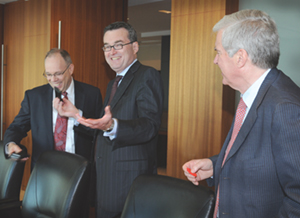As McMillan LLP and Lang Michener LLP are about to discover, integrating law firms into a single unit is a daunting task.

But in their case, it could be more difficult than usual.
The prevailing wisdom is that the emergence of Canada’s 12th-largest law firm results from the combination of two entities: McMillan and Lang Michener.
But, as lawyers would say, that’s the form of the transaction. The substance is another matter.
At the heart of the distinction between form and substance lies the fact that Lang Michener may be a single firm in name only.
The current form emerged in 1989, when Lang Michener absorbed Vancouver firm Lawrence & Shaw, which, with the recently established Hong Kong office, constitutes its western division. Toronto and Ottawa make up the eastern division.
Although both divisions fell under the Lang Michener banner, they have operated as separate profit centres for most of the past 21 years. Indeed, even the hierarchical nomenclature is different: Robert Cranston, who heads the eastern division, has the title of managing partner; François Tougas, Cranston’s counterpart in Vancouver, is the western division’s chairman.
“Out West, we weren’t really thinking about the East, although we did do some joint stuff and combined on national expenditures,” Tougas says.
That was so much so that a continuing issue in almost a year of negotiations was whether Lang Michener would fit into McMillan’s national income pool model.
“Our greater concern was how the western division partners would behave in an income pool,” Tougas says. “What we wanted this time was a true national merger but as we came to understand what it meant, it was much harder to implement than to talk about it.”
Now Tougas is confident that Lang Michener is fully behind the merger.
“The level of consensus in Vancouver is very high,” he says.
“So much so that I can say with confidence that our partners have already committed themselves emotionally to the merger and to the idea that its primary driver is about adding value for our clients.”
Andrew Kent, McMillan’s chief executive officer who will become the new firm’s CEO when the merger takes effect on Jan. 1, agrees that internal integration was his No. 1 concern.
“The proposition to merge fit with our overall strategic plan, but we wanted to have a real shot at integration,” he says. “Otherwise, we would be bulking up our numbers instead of becoming a real firm.”
In fact, integration was on the table from the outset. “Early on, we had unanimous support for the concept at McMillan, but ensuring that the Lang Michener partners committed as well was a process that took some time,” Kent says.
Kent credits Tougas and Cranston with doing the legwork that produced a final consensus. “The support for a concept built around integration is now overwhelming,” he says.
At the same time, Lang Michener has practice areas that the current McMillan doesn’t, such as its Supreme Court advocacy group, that will allow the firm to offer a more comprehensive range of services.
In the meantime, one advantage Kent has is that he’s not lacking in experience with mergers. The current version of McMillan emerged from Toronto-based McMillan Binch LLP’s combination with Montreal firm Mendelsohn in 2005 and a subsequent amalgamation with most of the Calgary office of Thackray Burgess in 2009.
“Mendelsohn, for example, was an ethnic firm that included a group of younger French-Canadian partners, so we in Toronto had to learn how to accept other systems and a different culture,” Kent says.
“The upshot is that from an attitudinal standpoint, we’re much better equipped to be good partners than when we expanded to Montreal.”
There’s no doubt that McMillan has come a long way.
“I was involved in the merger discussions that took place in 1999 among McMillan Binch, Byers Casgrain, and Bull Housser Tupper,” Kent recalls.
“I remember some of the partners at Bull Housser saying that they didn’t know that the McMillan lawyers were prepared to be good partners in the deal. It was obvious that we’re going to have to do better on that level in the future.”
Arguably, the fact that a venerable name like Lang Michener will disappear under the McMillan banner augurs well for the new enterprise.
“We felt we had to use a single name that symbolized a unified firm in order to be competitive in the national legal marketplace,” Cranston says.
For his part, Kent believes the greatest challenge faced by the new firm will be creating a trustworthy organization. “It won’t happen automatically,” he says. “The partners will give you the benefit of the doubt for a while, but ultimately you have to earn a reasonable level of trust in a relatively short time.”

 But in their case, it could be more difficult than usual.
But in their case, it could be more difficult than usual.